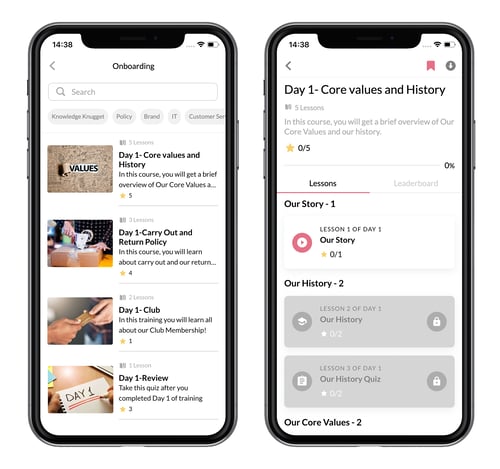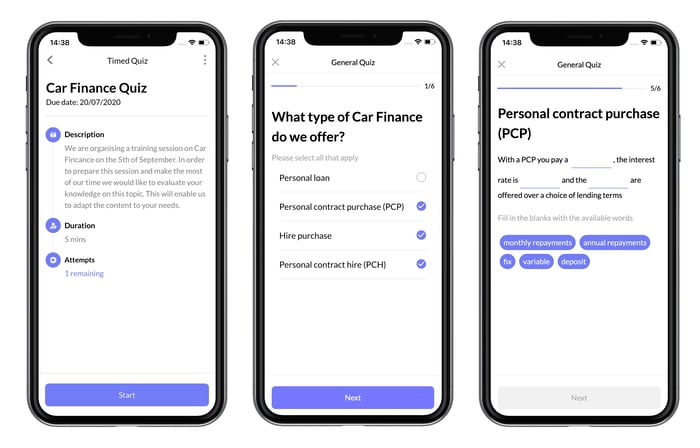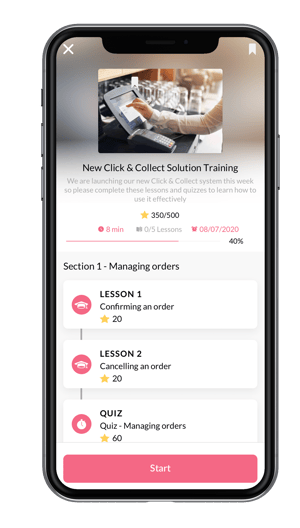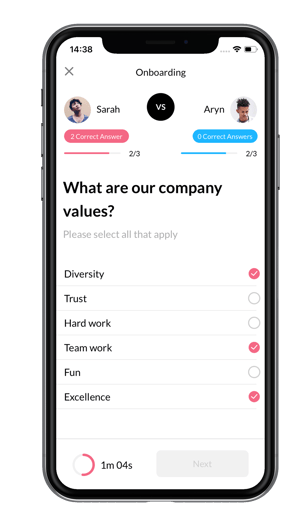Dec 15, 2021 8:08:29 PM
Training & learning
Dec 15, 2021 8:08:29 PM
Training & learning

Microlearning is a fast, easy and fun way to train employees, and it's taking the world by storm.
The microlearning industry is forecasted to grow to 2.7 billion USD by 2024.
Related: A Guide to Microlearning and Why Your Employees Need It
But when is the right time to use microlearning in your workplace training, and why?
Here are 7 microlearning examples to make your training the best it can possibly be.
The way you onboard new hires determines how they'll perform on the job.
It also sends them a clear message about whether or not they're valued as employees.
And unfortunately, most employees aren't liking that message a whole lot.
Over 88% of people think the way their company onboards new joiners leaves a lot to be desired.
Related: Improving Onboarding for Retail Teams: Top Tips
Most onboarding doesn't give new employees the knowledge and skills they need to succeed in their roles. And ultimately, that costs employers, because it makes turnover more likely.
20% of new hires leave a job within just 45 days - but good onboarding increases retention by 25%.
Good onboarding teaches employees exactly what they need to know to start succeeding right away, but doesn't overload them with unnecessary information.
And that's what makes microlearning such a great tool in an employer's onboarding arsenal.
Microlearning gives new hires a safe space to apply the information they've learned in hypothetical situations, like quizzes and battles with peers. That way, they're completely prepared for success when they get out there on their own.
For example: Use microlearning to divide up an employee's first week into easily digestible chunks. Give each day an overall topic, like brand values, and assign employees micro-courses on those topics.

The majority companies are planning to return to some level of classroom-based training post-pandemic. Yet only 8% are planning to use this as their only training format.
Studies have shown that blending traditional classroom based learning with online and peer-to-peer discussions helps learners retain information and master new skills faster.
Microlearning doesn't have to replace in-person learning entirely, it can complement it.
For the foreseeable future, video calls will replace in-person sessions. Without the right strategy, employees run the risk of learners zoning out.
Being "all Zoomed out" for the day is a feeling we can all relate to these days.
Use microlearning to quiz employees before, after and during video sessions to make them more engaging, and get a pulse on how your learners are feeling and what they've retained.
Blending microlearning with face-to-face learning will help you make the most of the limited time you do have with your employees.
For example: Send participants a quiz before the session, halfway through and immediately afterwards to help them retain the information, then put those scores on a leaderboard to ignite some friendly competition!

Replacing existing tech or investing in new systems is becoming increasingly common.
But nothing is guaranteed to get an eye roll from your learners like scheduling an hour long training on a new tool.

But with microlearning, you can get your employees up to speed on a new tool by actually walking them through it, step by step. That beats reading a long, boring manual any day.
It's also a much more cost effective way to train employees. Considering how much organizations invest in choosing, purchasing and scaling systems, equipment and tools, cost reduction is a huge reason to use microlearning.
For example: Many retailers we work with plan to continue offering curbside pickup or click and collect post pandemic restrictions, and have quickly ramped up store teams on the new systems using the YOOBIC learning platform.
Some even create microlearning paths tailored to an employee's role, like specific courses for using Shopify or a new POS system as a store manager, or a new WMS.
Related: How to Get Reluctant Employees On Board With Using New Tech
80% of training is forgotten 3 days after its learned. What's the point of spending hours on training employees if the information isn't being retained?

That's where microlearning comes in.
Since each microlearning session is formatted around one applicable piece of knowledge, you can and should end each session with a quiz.
Cognitive Load Theory stipulates that a person's working memory can only hold 5-9 objects at one time before becoming overloaded. Successful learning is focused on transferring those objects into a learner's long-term memory - by doing.
Finishing each session with a quiz - and requizzing on the same knowledge at regular intervals - is just one of the many ways microlearning can boost information retention
For example: Change up your quizzes with different formats, like missing words, image selectors and more!
Everyone learns differently. And the best way to make knowledge stick is through revisiting topics whenever you feel like you need it.
Workplace learning should be like a tasty buffet, not like a sit-down restaurant where all the waiters are so busy they never come over to ask you if you want any dessert.
Combining microlearning with mobile learning is the best way to make your learning accessible, so learners can go back and revisit training content, wherever they are.
For example: Create a course library of microlearning content that employees can access whenever they feel like they need a refresh.
It's a huge bonus if your microlearning platform has an offline feature, so employees can download and complete courses on the go.
One of the biggest problems with conventional workplace training is that it's a challenge to quantify its success.
Even when you've gathered every employee in the same room, there's no way of measuring how much of the information has stuck, until it's too late.
Microlearning is a great way to get visibility into how employees are interacting with your training content.
The whole purpose of microlearning is to reformat training around one standalone, self-contained and applicable topic, which makes it possible to measure how well that topic is being applied.
Micro-course completion rates and quiz scores are great metrics to start measuring. The give you insight into what's sticking with your learners and what isn't, so you can change up the format or content if necessary.
And at a higher level, using microlearning as a way to quantify the impact of your training helps you justify investments, build business cases and improve the employee experience.
For example: Find out which microlearning content format is the most effective by testing 2 different ones, like video and an infographic, and compare course completion rates between the two.
Use a dashboard to display course analytics in real-time, so you can quickly take action if you notice scores or completion rates start to slump.

Often it's not practical, possible, or cost effective to get all your employees together in one place to train them up on an important topic, like a new product launch or a new return policy.
Replacing in-person sessions with a lengthy Zoom call isn't exactly engaging for your learners, either.
As an employer, you want 100% confidence that every employee has both completed the training and retained the information.
Related: Confidence-Based Learning: What It Is and Why Your Frontline Employees Need It
The beauty of the microlearning format is that it both boosts information retention and gives employers traceability into who's completed the training and who hasn't.
With the right authoring tool, it's easy to create new courses in a flash and push them out to your employees. If your authoring tool has a drag-and-drop functionality, pushing out courses is even easier.
Not only does this give peace of mind, but it can also help your organization meet compliance regulations and protect customer and employee health and safety.
For example: We've seen many of our customers use microlearning to train teams on COVID-19 sanitation protocols.
Some have set up a dedicated COVID-19 course library that employees can access whenever and wherever they feel like they need a refresh.
--
Microlearning has the power to transform your workplace training into a tasty buffet of learning.
With the right microlearning strategy, your employees will go back for seconds, thirds and fourths!
Empower your workforce to learn faster and perform better with YOOBIC's mobile microlearning platform!
Search the blog

See why 350+ businesses are using YOOBIC
YOOBIC creates a better everyday working experience for frontline teams while helping businesses drive performance at scale.
PRODUCT
See why 350+ businesses are using YOOBIC
YOOBIC creates a better everyday working experience for frontline teams while helping businesses drive performance at scale.